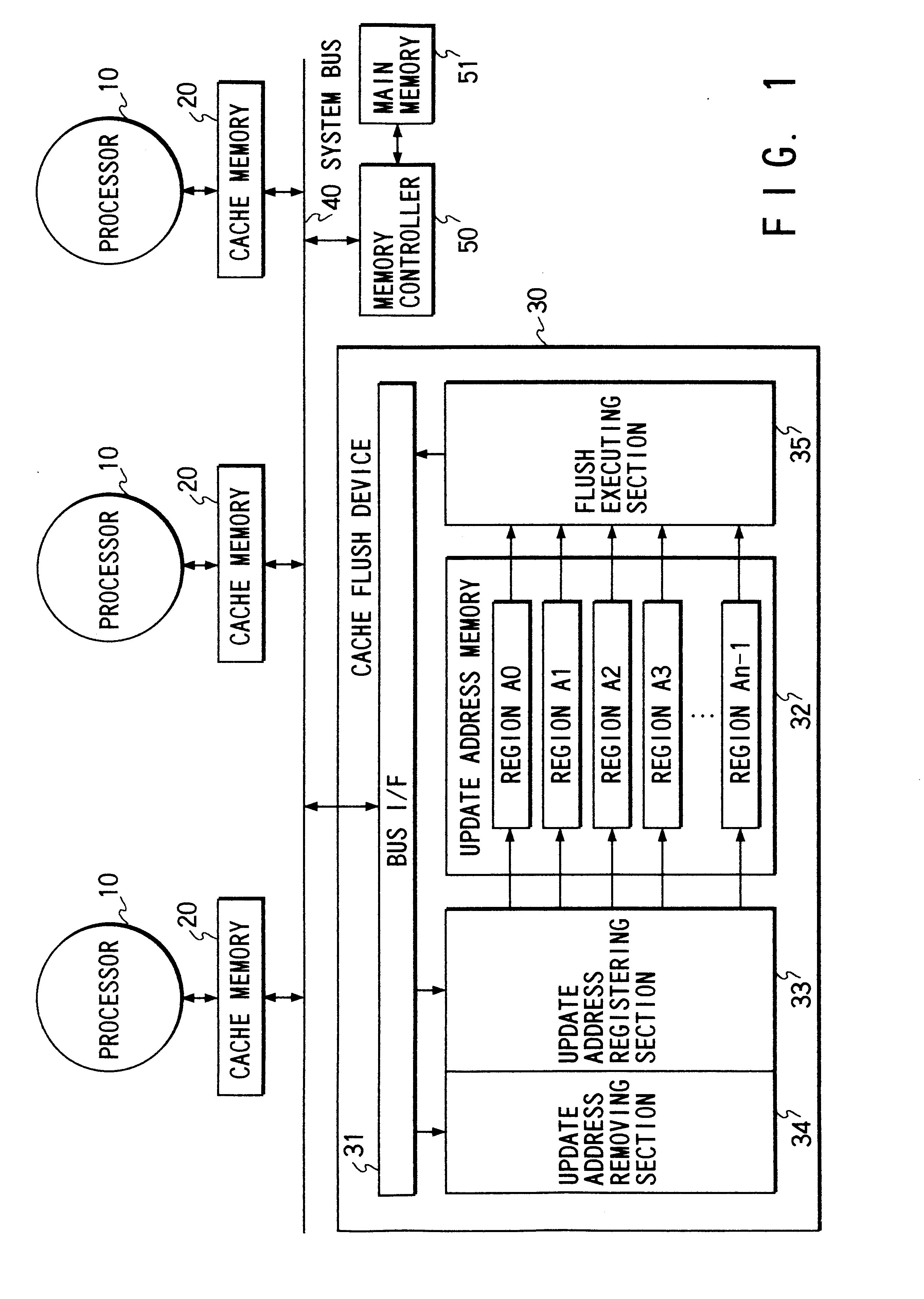Cache flush apparatus and computer system having the same
a technology of cache memory and flushing apparatus, which is applied in the direction of memory adressing/allocation/relocation, redundancy hardware error correction, instruments, etc., can solve the problems of requiring a major modification of the present cache controller design, the inefficiency of a cache flush is apparently more critical, and the frequentity of cache misses during normal data processing. achieve the effect of accelerating the creation of checkpoints and increasing system performan
- Summary
- Abstract
- Description
- Claims
- Application Information
AI Technical Summary
Benefits of technology
Problems solved by technology
Method used
Image
Examples
first embodiment
(First Embodiment)
FIG. 1 is a block diagram showing the configuration of a computer system according to the first embodiment of the present invention. Each processor 10 has its own copy-back type cache memory 20 with a cache coherency mechanism and is connected to a system bus 40. In a case where the configuration of the cache memory 20 is two level (namely comprises primary and secondary cache memories) or more, the cache memory according to this embodiment means the cache memory nearest to the system bus 40. In case where a cache memory comprises an instruction cache memory and a data cache memory, the cache memory according to this embodiment means the data cache memory. The system bus 40 according to this embodiment has 32 bit width.
A cache flush device 30 and a memory controller 50 for a main memory 51, are connected to the system bus 40. The cache flush device 30 includes a system bus interface 31, an update address memory 32 (consisting of regions A.sub.0 to A.sub.n-1), an up...
second embodiment
(Second Embodiment)
A second embodiment of the present invention will now be described. FIG. 16 shows the structure of a computer system according to the second embodiment of the present invention. The structure of the computer, to which the cache flush device 30 is applied, is the same as that according to the first embodiment.
The cache flush device 30 comprises the system bus interface 31, update address memory 32 (regions A.sub.0 to A.sub.n-1), update address registering section 33, flush executing section 35 and an entry reclaiming section 36.
The update address memory 32 is composed of n regions (regions A.sub.0 to A.sub.n-1) for storing addresses of all of the dirty blocks. In this embodiment, the addresses of all the dirty blocks are stored in the update address memory 32. However, the update address memory 32 may also hold addresses of the associated cache block which is not dirty. The reason for this is that the update address removing section 34 of the first embodiment is om...
third embodiment
(Third Embodiment)
A third embodiment of the present invention will now be described.
FIG. 21 shows the structure of the computer system according to the third embodiment. The cache flush device 30 is applied to the same computer as of the first and second embodiments.
The cache flush device 30 comprises a system bus interface 31, update address memory 32 (regions A.sub.0 to A.sub.n-1), update address registering section 33, update address removing section 34, flush executing section 35 and entry reclaiming section 36.
The update address memory 32, the update address registering section 33, the flush executing section 35 and the entry reclaiming section 36 are the same as those according to the second embodiment.
The difference from the second embodiment is that the update address removing section is added like the first embodiment. While the update address removing section of the first embodiment, when a write-back bus command is observed, always seeks and clears the entry having the ad...
PUM
 Login to view more
Login to view more Abstract
Description
Claims
Application Information
 Login to view more
Login to view more - R&D Engineer
- R&D Manager
- IP Professional
- Industry Leading Data Capabilities
- Powerful AI technology
- Patent DNA Extraction
Browse by: Latest US Patents, China's latest patents, Technical Efficacy Thesaurus, Application Domain, Technology Topic.
© 2024 PatSnap. All rights reserved.Legal|Privacy policy|Modern Slavery Act Transparency Statement|Sitemap



